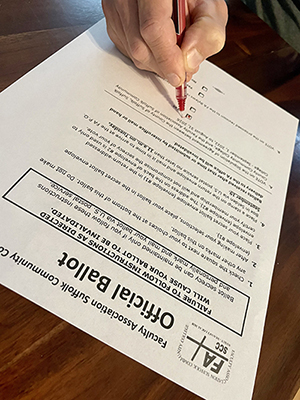Courtney Brewer
As you know from Dante’s cover story, on September 19 the FA membership overwhelmingly supported our new stipulation of agreement with the college that we began negotiating last year, and it was unanimously passed during the September 21 college Board of Trustees meeting as well. I learned a lot about crafting contract language, why sometimes that language is deliberately vague or not explicit and why some things are left out altogether. Our FA contract is a robust, mature document (the FA turned 53 this year!) that is 85 pages long, not including another 80 pages of appendices. The current stipulation of agreement only covers the items that were negotiated this year. Sometimes members bring issues to our attention that they personally feel very strongly about and want to know why it was not a subject taken up in this round of negotiations. First, we did not open up the entire contract, with good reason, since the majority of the items in it are working well for our members. Once the entire contract is opened up, literally every single provision is on the table, which means we risk losing some provisions that the FA has battled for decades to achieve. Second, the items brought forth for consideration were decided upon in collaboration with our negotiations team. The negotiations team has representatives covering a broad range of disciplines and constituencies in our membership. The process begins with our contract negotiations surveys. In this round of negotiations, we had not just one but two adjunct surveys as well as one full-time member survey. The negotiations team pores over those survey results and uses the member feedback, both quantitative and qualitative (open comments), to determine the highest priorities of the membership at this point in time. Not everything makes the cut; we work with the issues that the majority of our members tell us they care most about. The negotiations team also had committees focused on top priorities as well. We greatly appreciate the work of all our negotiations team members throughout this process. This stipulation, if approved by the County Legislature, will be added to the list of previous stipulations, which have been added to the last version of the full contract which was our agreement covering 2001-05 (all of which can be found on the contract page of the FA website). “Why did this take so long?” Some people asked me this past year, “Why wait until the current agreement expired to start negotiating? Why not start the year before it expired? We’ve been without a contract for a year now.” We did indeed wait for the previous agreement to expire on August 31, 2022. The college budget very much depends on several factors that fluctuate every year, the biggest of which is student enrollment. The budget office does its best to project what money will be available for the coming year, but as we all know there is very little we can predict with 100% accuracy when it comes to students. With enrollment down drastically since Covid, it was beneficial for us to wait until enrollment began to tick up, as we were hoping it would. “But where does it say that?” This gives us the room to work with administration and HR to facilitate something that will work for both parties—precisely because it is not spelled out in the contract, which could restrict us in terms of our options. When a brand new item is proposed, both sides have to carefully consider what it could mean. These are the items that took the most time in negotiating this latest agreement. When people complain about “the FA contract” Every negotiation is a discussion, and there were items that we went back and forth on with college administration. There were issues that both sides refused to budge on, but most items were the result of several discussions, some of which took the entire year to reach agreement on. |
